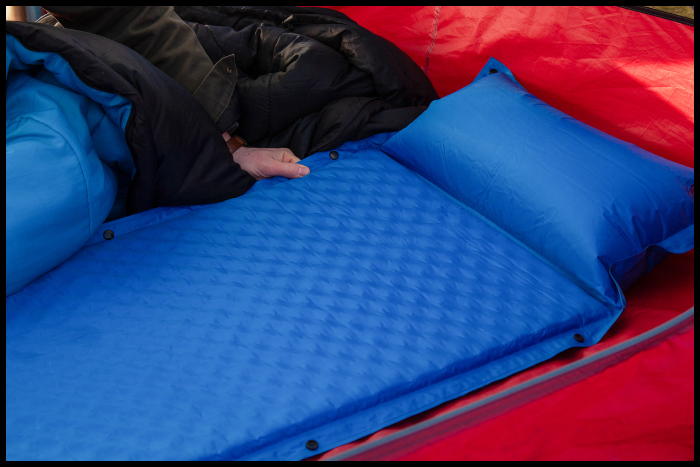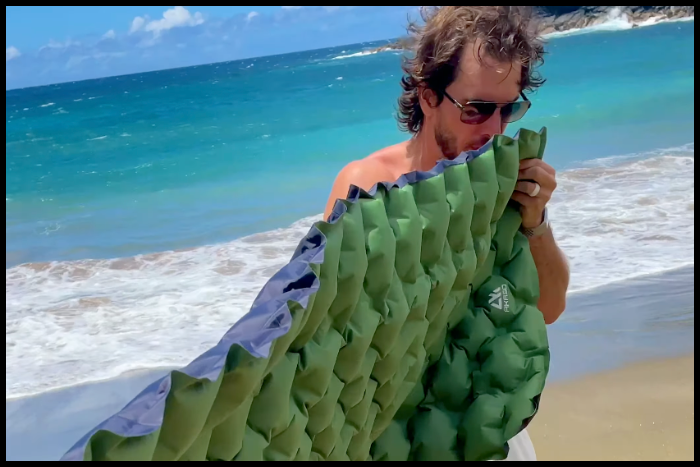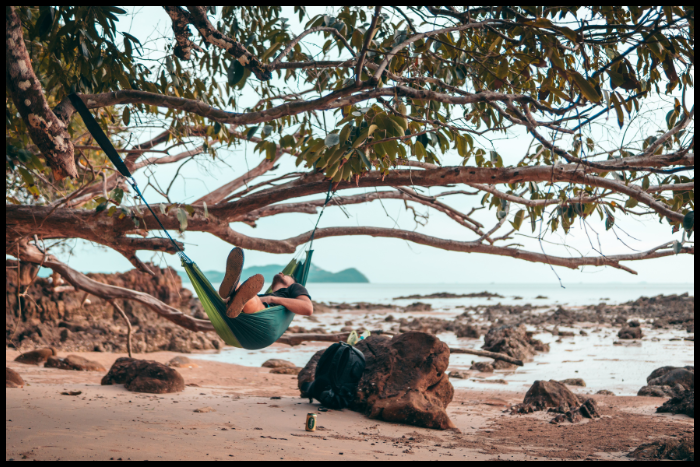Are you curious about what you should sleep on when camping at the beach? Many campers fantasize about sleeping on the soft sand, but it may not be as comfortable as they imagine. You should know what equipment you need to comfortably camp on the sand and keep warm during the long nights on the beach.
A sleeping pad is a great idea when camping on the beach. Look for high R-values that keep your body heat from transferring to the sand. Closed-cell foam pads are light and versatile. You can sleep in a hammock if there’s a place to hang it. You can also pitch a tent and bring a warm sleeping bag.
If you’re ready to learn more about finding a comfortable way to camp on the beach, here’s what you need to know.
What to Sleep on When Camping at the Beach?
One of the major benefits of camping is the ability to unplug and unwind. (Do check out my guide on beach camping benefits for more details)
Sleep is an important part of this relaxation, so you want to ensure you get the best sleep possible.
To this end, you must know what to sleep on to camp comfortably. What do you need to make this camping trip as comfortable as possible?
Here are a few ideas to help you make the most of your beach camping trip. Also, don’t forget to check out my guide on planning a beach camping trip.
1. Sleeping Pad
Most campers who intend to spend an evening on the beach will want to use a sleeping pad. This is particularly true if you’ll be camping in the middle of a cold snap or during the winter.
Body heat easily transfers from your body to the cold sand beneath you. The result is that you’re left shivering and uncomfortable. It’s not the best way to get a good night’s rest.
Instead, you should invest in a high-quality sleeping pad with a high R-value. Remember that sand is a bit softer than other terrains, so you may not need a thick sleeping pad.
Its cushion is nice if you stay on packed sand that can be harder or more uncomfortable. The R-value is the more important thing to pay attention to when shopping.
Even during the summer, you might be surprised by how cold the beach and sand can get. You’ll be in the middle of a near-constant breeze and may even be wet.
Both of these can make things extra chilly. You won’t want to lose extra body heat, so invest in a sleeping pad.
Check out my recommendations for the best camping sleeping pads.
The two most popular types of sleeping pads for beach camping are closed-cell foam and air pads.

Closed Cell Foam
If you have a decent way to trek from your car to your campsite, you might find that every extra ounce counts. As a result, a closed-cell foam pad might be the best option.
They’re the least expensive type of sleeping pad you can buy, but that doesn’t mean they aren’t durable. These sleeping pads are less likely to puncture and perform great under inclement conditions.
Keep in mind that they don’t provide much in the way of cushion, but this may not be necessary when camping on the sand.
Another great benefit to closed-cell foam sleeping pads is that they can be brushed off easily to keep them sand-free.
This allows them to double as a sitting pad around the campfire if you want to stay warm or keep your body off the sand.
Air or Self-Inflating Pads
When comfort is the name of the game, you’ll want to be prepared with an air pad. You can get them as thick as you want, making them ideal for luxurious camping experiences.
They’re also easy to adjust to your sleeping preferences: add more air for a firmer experience or less air for a softer mattress.
The only real downside to an air mattress is that it can easily be punctured or ripped. They’re also a bit more expensive than the basic closed-cell foam sleeping pad.
Some of these pads can be self-inflating, so you don’t have to worry about blowing them up when setting up the campsite.
They come in various R-values, so aim to get the highest one your budget permits. This’ll be ideal for camping at the beach during any season.

2. Sleeping Bag
When you picture the beach, do you automatically envision long, hot days in the sun? While this may be true for mid-afternoon, the temperatures can take a deep nosedive once the sun sets.
To this end, you want to be sure you’ve come prepared with enough blankets to keep you warm, especially if you choose not to use a sleeping pad.
If you have a warm winter sleeping bag, such as a zero-degree sleeping bag, you should bring it. Worst case scenario, you can unzip it and throw the covers off.
However, you’re much more likely to want the extra warmth and insulation this offers. It’s always better to be prepared for the inevitable temperature drop at night.
Check out my recommendations for the best sleeping bags.
3. Hammock
If you’re determined that spending the night on the sand may not be for you, you should look for a spot to tie a hammock.
A hammock doesn’t allow your body heat to leave your sleeping bag and transfer to the cold, hard sand beneath you. This makes it inherently more comfortable than sleeping on the sand.
Make sure you come prepared with a sleeping bag and blankets, though.
While keeping these items with you in a narrow hammock can feel a bit bulky, you’ll be glad you brought them when the temperatures drop dramatically after the sunset.
I’ve compiled a list of the best camping hammocks to help you with the decision.

4. Set Up a Tent
Sleeping in a tent is always a good idea when staying on the beach overnight. First and foremost, a tent will keep you dry from ocean spray and other water in the air.
When you get wet and the temperatures at the beach drop, you’ll be even colder than usual. A waterproof tent helps you to stay dry and warm.
I have written a complete tutorial on waterproofing your tent which might benefit you.
Of course, you’ll also want all of the standard gear inside your tent, such as blankets and a quality sleeping bag.
This allows you to adjust comfortably based on your comfort level as the temperatures drop.
If you don’t have a sleeping pad, you can use some of your blankets to keep you from transferring your body heat into the cold sand.
The tent can help a little bit if you sleep on the tent’s floor over the sand. However, it won’t keep you as warm as a sleeping bag or compared to what a sleeping pad with a higher R-value can offer.
Check out my recommendations for the best beach tents to find reliable options.
Sleeping Pads Are Your Best Bet
Are you prepared to sleep on the beach when the temperatures drop at night? You’ll want some protection from the cold sand, so it’s recommended that you bring along a sleeping pad.
While you can sleep directly on the sand with a warm sleeping bag or a tent, a sleeping pad is your best bet for staying warm and comfortable.
A hammock can also be a great option if there’s a place to hang it. Consider what gear will help you comfortably camp on the beach before your next trip!
